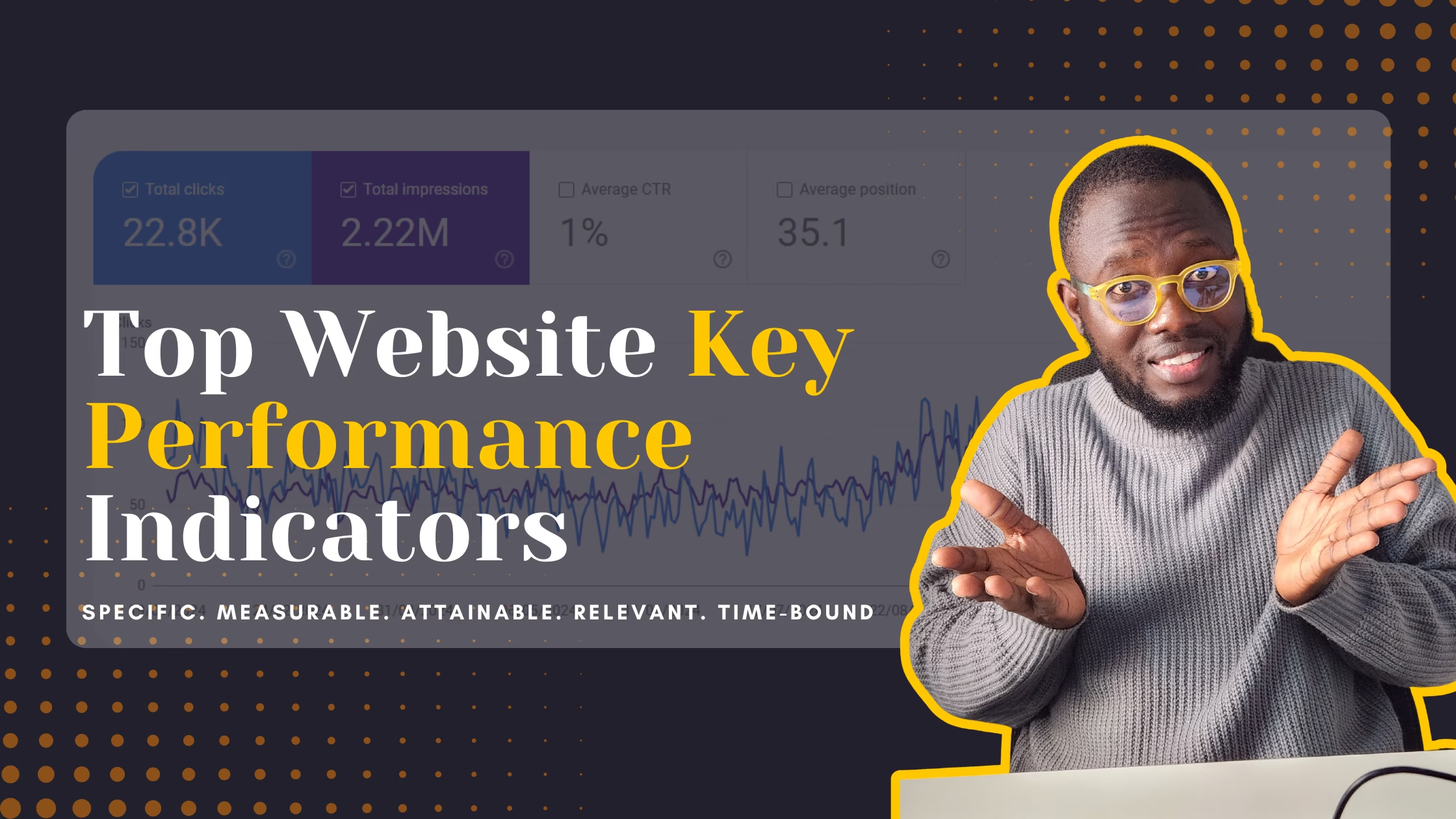Introduction
Your Website’s Key Performance Indicators (KPIs) are the essential metrics to evaluate the performance and effectiveness of your business’s online presence.
Understanding and analysing these KPIs will help you identify areas for improvement, how to track progress, and how to align your website strategy with your business goals.
In this blog post, we’ll delve into the definition of KPIs, provide an exhaustive list of website KPIs to note, discuss how to check these KPIs, explore benchmarks by industry, and highlight which departments address issues related to each KPI.
What Are Website Key Performance Indicators (KPIs)?
Website KPIs are measurable values that indicate how effectively your website achieves its objectives.
They serve as benchmarks for assessing the success of various aspects of a website such as traffic, user engagement, conversions, and overall performance.
Some key elements of effective KPIs include:
- Specificity: Your metrics can be clearly defined and tied to objectives.
- Relevance: Your metrics must be able to align with business goals.
- Measurability: Your metrics must be quantifiable for evaluation.
- Timeliness: Your metrics can be monitored periodically for actionable insights.
- Achievability: Your metrics must be realistic and can be set as attainable targets/goals.
For example, if a company’s goal is to increase online sales, one relevant KPI it could pursue will be the conversion rate.
Some Examples Of Website KPIs: An Exhaustive List
1. Traffic-Related Metrics:
These metrics provide a foundational understanding of your small business website’s reach and visibility.
They help you identify where your traffic is coming from, how many people are visiting, and how they are interacting with your site.
Some common examples are:
- Overall Traffic: Total number of visits to your website.
- Unique Visitors: The number of distinct users visiting your site within a specific timeframe.
- Traffic Sources: Breakdown of traffic to your website by their source, such as organic, direct, referral, social, and paid.
- Session Duration: Average time spent on the website per session.
- New vs. Returning Visitors: The percentage of new and returning visitors.
2. Engagement-Related Metrics
Engagement metrics reveal how effectively your website is capturing and holding visitor attention.
They help you understand whether your content is resonating with your audience and encouraging them to explore further.
Some common examples include:
- Bounce Rate: Percentage of visitors who leave without interacting with your website.
- Pages Per Session: The average number of pages viewed during a single session (or use of your website).
- Scroll Depth: How far users scroll on a webpage on your website.
- Social Shares: Number of shares your content receives on social media.
- Comments: Engagement on blog posts or discussion forums.
- Downloads: Number of downloads for resources on your website (e.g., ebooks, white papers).
3. Conversion Metrics
These metrics directly measure the success of your website in achieving its primary goals, such as generating leads, driving sales, or encouraging sign-ups.
- Conversion Rate: Percentage of visitors completing desired actions (e.g., making a purchase, signing up for a newsletter).
- Cart Abandonment Rate: Percentage of users adding items to a cart but not completing the purchase.
- Lead Generation Rate: Number of leads generated per visit.
- Cost Per Acquisition (CPA): Cost of acquiring a new customer.
- Customer Conversion Rate: Percentage of website visitors who become paying customers.
4. Performance Metrics
Performance metrics focus on the technical aspects of your website, ensuring it functions smoothly and efficiently.
These metrics are crucial for providing a positive user experience and improving search engine rankings.
Some common performance metrics are:
- Page Load Time: Average time it takes for a page to load.
- Time to First Byte (TTFB): Time taken for the server to send the first byte of data.
- Mobile Responsiveness: How well the website performs on mobile devices.
- Error Rate: Frequency of errors, such as 404 or server issues.
5. SEO Metrics
These metrics measure your website’s visibility and ranking in search engine results pages (SERPs).
They help you understand how well your website is performing in organic search and identify areas for improvement in your SEO strategy.
Common SEO metrics include:
- Organic Traffic: Traffic coming from search engine results.
- Domain Authority (DA): A score predicting your website’s ability to rank on search engines.
- Backlinks: Number and quality of links directing to your website.
- Keyword Rankings: Position of targeted keywords in search engine results pages (SERPs).
6. Retention Metrics
Retention metrics help you understand how effectively your website is retaining visitors and building long-term relationships with customers.
Common metrics to identify this include:
- Returning Visitor Rate: Percentage of visitors who come back to the website.
- Customer Lifetime Value (CLV): Total revenue a customer generates over their lifetime.
- Churn Rate: Percentage of users who stop engaging with your site.
Tools For Tracking Your Website’s Key Performance Indicators
1. Use Google Analytics
Google Analytics is a powerful tool for tracking traffic-related KPIs, engagement-related KPIs, and some conversion-related metrics, such as :
- Overall traffic
- Bounce rate
- Session duration, and
- Conversion rate
However, if integrated, you may get metrics such as event tracking, e-commerce average order value and product performance, as well as SEO metrics.
2. Google Search Console
For monitoring SEO-related KPIs, such as organic traffic and keyword rankings, Google Search Console provides actionable insights.
3. Heatmap Tools
https://www.crazyegg.com/Tools like Hotjar and Crazy Egg will help you track engagement metrics such as scroll depth and click patterns.
4. Page Speed Insights
Google’s PageSpeed Insights evaluates page load time and offers suggestions for optimization.
5. CRM and Marketing Platforms
Platforms like HubSpot or Salesforce can track conversion metrics and customer engagement.
Common Benchmarks for Some Website KPIs by Industry
| KPI | E-commerce | SaaS | Media/Content | Healthcare |
|---|---|---|---|---|
| Bounce Rate (%) | 20-45 | 30-55 | 40-60 | 35-50 |
| Conversion Rate (%) | 2-5 | 7-10 | 1-2 | 2-3 |
| Average Page Load Time | < 3 seconds | < 3 seconds | < 4 seconds | < 3 seconds |
| Returning Visitor Rate (%) | 30-50 | 40-60 | 20-40 | 30-50 |
| Organic Traffic Growth (%) | 10-30 | 20-40 | 10-25 | 15-30 |
What Departments Are Responsible For Each Of Your Website KPIs?
1. Traffic Metrics
- Department: Marketing and SEO teams.
- Resolution: Optimize campaigns, enhance SEO, and target new audiences.
2. Engagement Metrics
- Department: Content/Web Copy and UX/UI design teams.
- Resolution: Improve content quality and user interface.
3. Conversion Metrics
- Department: Sales and CRO (Conversion Rate Optimization) teams.
- Resolution: Streamline the sales funnel and reduce friction points.
4. Performance Metrics
- Department: Web development and IT teams.
- Resolution: Enhance server performance, compress files, and ensure mobile optimization.
5. SEO Metrics
- Department: SEO and content teams.
- Resolution: Conduct keyword research, and improve on-page and off-page SEO.
6. Retention Metrics
- Department: Customer success and product teams.
- Resolution: Enhance user engagement strategies and improve loyalty programs.
Conclusion
Tracking and analyzing website KPIs is important for sustained growth and success. A good understanding of these metrics will help your business make informed decisions, enhance user experience, and achieve its business goals.
Each KPI offers unique insights into your website’s performance, and when monitored consistently, can pave the way for continuous improvement.
Remember, the key to effective KPI management is collaboration among all of these departments, getting actionable insights, and consistent optimization efforts.
Start tracking your website’s KPIs today to unlock its full potential!
Work With Temitayo
To get me working on your freelance, SaaS or Agency website copy, send a message or schedule a meeting here






